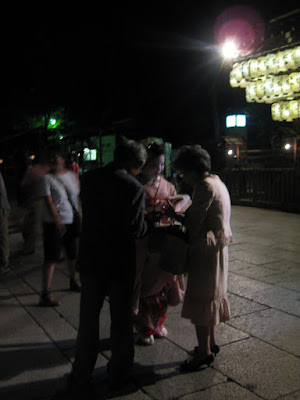
It is no surprise to people with slightest knowledge about/interest in Japan, that Kyoto, the previous capital of Japan, is one of the most historically rich and architecturally riveting cities in the world (a UNESCO treasure as well, of course). Here with the astonishing old Royal Palace, hundreds of temples and pagodas (and I keep forgetting which belong to which religion), a week would still not be enough to pay full due respect to all these marvelous buildings. And yet, here I am, an ignorant tourist, who can barely appreciate anything on her 3-day-trip in the middle of the PII program (we had a "semester break").
Well, a couple of factors. One, 3 days is way too short. But also, summer's generally a bad time - hot, humid and crowded. And finally, but probably most terribly, we had way too many people. It is impossible to do or see anything with more than 3 heads thinking. We had a total of 10 (!). Which means, it took forever to decide where to go or what to eat (or rather where to drink in our American case). My first lesson was that, if independently of a tour, always travel in pairs. This over-crowdedness of PII students resulted in me seeing less than I wanted, less than I definitely should have. A scorching, humid sun and temperature of more than 32C did NOT aid me in my quest to discover more of this interesting city.

Well we did hit the main attractions though - the Golden Pavillon (金閣寺 Kinkaku-Ji)and the Nijou Castle (二条所 Nijo-jo) etc. And although far from my plans, we had excursions of our own, rather unplanned, but equally interesting I must say, of which I devote the next posting. Golden Pavillon, as the name indicates is covered all in gold - something really worth seeing. According to Wikipedia (my Harvard TFs would probably chide me viciously for referencing this kind of source), it was built as retirement lodge for a famous shogun (chief samurai) within his big private estate. Man, people used to be rich right?

As for Nijou Castle, that belonged to yet another shogun (again not an emperor, just the highest samurai) where I finally saw the all-famous nightingale floor, of which I read so much from this once very bestseller book, "Across the Nightingale Floor" by Lian Hearn (I read it when I was still in middle school, which is some ages ago, but I do remember I was quite crazy about it). This famous wooden floor makes sounds like nightingale everytime it is being stepped on - back in the day it was supposed to help reveal ninjas and assassins if they entered the castle at night. Well, now with the hundreds of tourist passing every day, it's just incredibly noisy.
During the tour of the castle's insides (camreas not allowed :() we sneakily followed an American high school tour group that was lead by a Japanese guide who spoke very fluent English. Thanks to that bit of stealing, I learned a good deal about the rooms and floor plans of the castle - in those, where shogun made his public appearances, he was always seated next to a sort of built-in door, behind which many samurai stayed hidden, ready to burst out and defend their master in case of a sudden attack. Yet, my favourite room was the shogun's bedroom. Apparently that was the only area no males were allowed in - whether they were shogun's male servants or his advisers or ministers. And therefore, shogun who was all alone with his many ladies, had no males to protect him. For that reason, these beautiful ladies in service, with long hair and long, complicated robes, who entertained him graciously with music and dance, were also out of necessity masterful at martial arts, concealing their deadly knives and swords just under their gracious kimono. Dead cool and sexy as far as I see it :).















.JPG)
.JPG)
.JPG)







